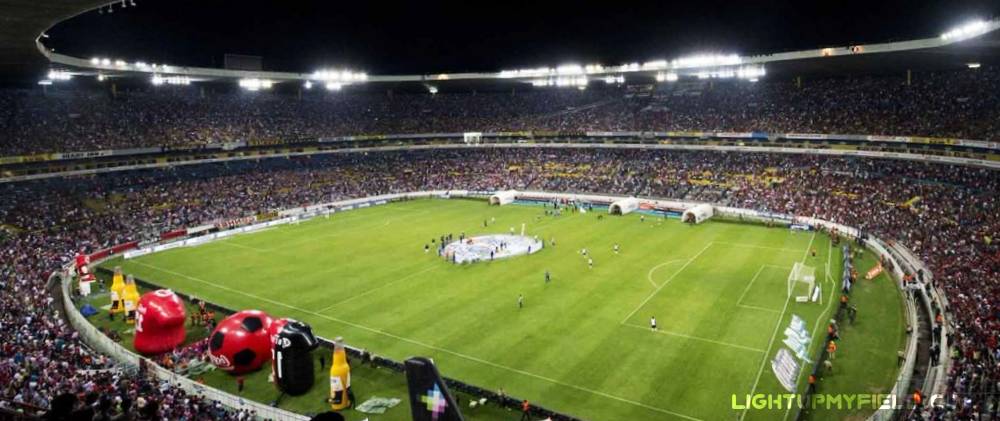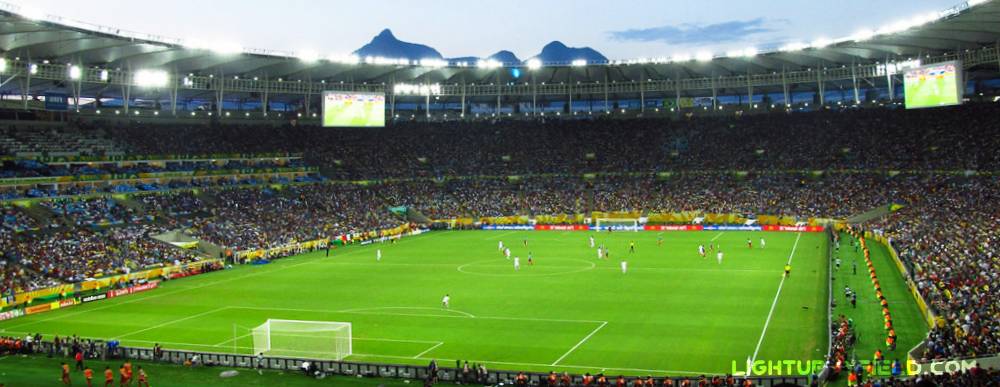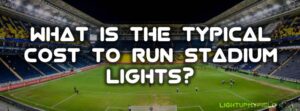
Upgrading stadium lighting for a school or youth sports field can be a game changer. Better lights mean evening games, safer training sessions, and even the possibility of hosting regional
Reach out now for a free lighting consultation
Lighting up a stadium is a mix of science, engineering, and even a little bit of art. Stadium lighting does more than just brighten the field—it affects player performance, the fan experience, and even how good the game looks on TV. Let’s break down the types of lights used, how designers figure out placement and brightness, and what all of this actually costs.
Table of Contents
ToggleLighting a stadium is more complex than it looks, and the type of light fixture you choose has a big impact on energy use, maintenance, and even the viewing experience for fans and broadcasters. Let’s break it down.

For decades, metal halide lamps were the workhorse of stadium lighting. They were widely used because they offered high brightness and a decent color rendering index (CRI), typically around 65–70. This was good enough for early television broadcasts and live viewing. A single metal halide fixture often ranged from 1,500 watts to 2,000 watts, and in some major stadiums, even 2,400-watt lamps were installed to meet broadcast-level lux requirements.
The downsides? Plenty. Metal halide lamps take 5–15 minutes to warm up to full brightness. If power is lost during a game, the entire lighting system needs that time to restart, which is far from ideal. Over time, these lamps degrade significantly, often losing 30% of their brightness after just 6,000 hours of use. They also operate at about 70–90 lumens per watt, which sounds okay—until you compare it to LEDs.
A large stadium requiring 1,500 lux across a standard 7,000 m² field might need 150–200 metal halide fixtures rated at 2,000 watts each. That’s 300,000 to 400,000 watts of installed load. For every hour of operation, at an average electricity rate of $0.12 per kWh, that’s about $36–$48 per hour just to run the lights—and that’s without factoring in maintenance and lamp replacements.
Enter LEDs, and everything changes. Modern LED stadium lights deliver 120–160 lumens per watt, nearly double the efficiency of metal halide lamps. They switch on instantly—no warm-up time, no waiting. Lifespans are dramatically better too, often 50,000–100,000 hours compared to 6,000–10,000 hours for metal halide lamps.
One major selling point for LEDs is advanced control. Stadium operators can dim the lights, change color temperatures, and even program light shows synced to music or player introductions. That’s why you see stadiums using lighting as part of the entertainment now, not just for visibility.
How does this efficiency translate to real savings? For the same 1,500 lux level on a 7,000 m² pitch, an LED system might only need 70,000 to 100,000 watts of power. That’s a 60–70% reduction in energy use compared to metal halide. Over a season, this can save tens of thousands of dollars in energy costs alone.
For smaller fields, LEDs range from 400W to 800W per fixture, often with 12–24 fixtures total, while professional stadiums may use 150–200 LED fixtures rated between 1,200W and 2,000W each. The difference between a small community pitch and an international stadium can be hundreds of thousands of watts—and millions in lifetime operating costs.
| Feature | Metal Halide Lamps | LED Stadium Lights |
|---|---|---|
| Typical Wattage per Fixture | 1,500–2,000 W (up to 2,400 W) | 400–2,000 W |
| Luminous Efficacy | 70–90 lm/W | 120–160 lm/W |
| Warm-up Time | 5–15 minutes | Instant |
| Lifespan | 6,000–10,000 hours | 50,000–100,000 hours |
| CRI (Color Rendering Index) | ~65–70 | 80–90+ |
| Power for 1,500 lux (7,000 m²) | 300,000–400,000 W | 70,000–100,000 W |
| Hourly Energy Cost (at $0.12/kWh) | $36–$48 per hour | $8.4–$12 per hour |
| Fixture Count (Pro Stadium) | 150–200 fixtures | 150–200 fixtures |
| Brightness Degradation | ~30% after 6,000 hours | Minimal over lifespan |
| Maintenance Frequency | High (lamp replacements every few seasons) | Low (rare replacements) |
The global shift toward LEDs isn’t just about cost savings. Broadcasters now demand higher standards: HD and 4K broadcasts require 1,500–2,000 lux and high uniformity, plus excellent color rendering (CRI 90+). LEDs make meeting those standards easier and more sustainable.
On top of that, many sports authorities, including FIFA and UEFA, have updated their regulations to encourage or even require LED systems in new stadium projects. LEDs also contribute to sustainability targets by reducing energy consumption and carbon emissions—an increasingly big deal for major sports organizations.
Lighting a stadium isn’t just about throwing as much light as possible on the field. It’s a balancing act that involves brightness, consistency, player comfort, and broadcast quality. Designers follow very specific principles to make sure the experience works for everyone—from the athletes to the fans watching on TV.

Lux is the unit that measures how much light hits the playing surface. It’s not the same as lumens (which measure total light output)—lux is what counts for visibility. A recreational soccer field might only need 200–300 lux, which feels bright enough for casual play. Step up to national-level competitions and you’re looking at 500–750 lux as the minimum.
For professional games—especially those broadcast in HD or UHD—the standard shoots way up. It’s common to see 1,500 lux as a baseline, with some stadiums pushing 2,000 lux or more to make sure every camera angle looks sharp and color-accurate. The difference is huge: imagine going from the brightness of a well-lit gym to something closer to an indoor photography studio.
Even if you hit those lux numbers, uneven lighting ruins everything. Shadows on the pitch can disorient players and confuse viewers. That’s why most global standards require a uniformity ratio of 0.7 or better. That means the darkest spot on the field can’t be less than 70% as bright as the brightest area.
To pull this off, designers need a careful mix of pole locations, mounting heights, and beam angles. It’s not just a question of “more lights equals better”—it’s about balance.
Color temperature sets the tone of the light. Too warm, and the field looks yellowish; too cool, and it feels harsh and clinical. For stadiums, the sweet spot is 4,000K to 6,000K, which produces a bright, crisp, daylight-like look without washing out team colors.
Then there’s CRI (Color Rendering Index), which affects how true colors appear under artificial light. For sports lighting, 80+ CRI is the baseline, but 90+ is the gold standard for HD and 4K broadcasts. A high CRI ensures the green grass looks lush and uniforms pop the way they do in daylight.
Light isn’t just about brightness—it’s also about how it hits the eye. Poorly aimed or overly intense fixtures can cause glare, making it hard for players to track the ball or for fans to enjoy the game. That’s why modern systems use visor attachments, shielded optics, and precision aiming to minimize glare while maintaining even coverage.

Here’s where the numbers get interesting. The count and wattage depend on the field size, mounting height, and target lux. A small community pitch might get away with 12–20 fixtures at 600W each, while a professional stadium often needs 150–200 fixtures, each rated between 1,500W and 2,000W for LED systems.
For example:
This is why modern LED technology is a game-changer—not just for performance, but for cutting energy bills by 60–70%.
Mounting height plays a big role in how lighting is distributed. Pro stadiums often mount fixtures on 30–40 m high poles or along the roofline for better coverage. Higher mounting spreads light over a wider area but also demands higher wattage per fixture to maintain brightness at ground level. Lower poles might allow for smaller wattage fixtures, but you’ll likely need more of them to avoid dark zones.
For anyone planning a new lighting system, official standards like BS EN 12193:2007 or FIFA’s lighting guidelines are the go-to references. They spell out everything from lux levels to glare limits to uniformity ratios, ensuring the design works for both live play and broadcast.
While these principles apply to permanent installations, they also matter for portable light towers. Even though portable units can be moved around for flexibility, they still need to meet key requirements like proper lux levels, uniformity, and glare control. Without careful placement and aiming, you risk uneven lighting, shadows, and reduced visibility—especially for competitive matches. High-quality portable towers with LED fixtures can be engineered to match professional lighting standards, making them a viable option for temporary or multi-use venues.
Lighting a stadium involves more than just picking out fixtures. There are three major areas where money goes: the upfront cost of buying and installing the lights, the ongoing electricity bills, and the cost of maintenance over the years.
The initial investment is where most stadium owners feel the pinch. LED fixtures dominate the market now, and while they cost more upfront than old-school metal halides, the long-term savings make them worth it. A single high-power LED stadium light typically falls in the range of $1,000 to $3,000 per fixture, depending on wattage, optics, and features like smart controls or RGB effects for entertainment.
For a professional stadium needing 150–200 LED fixtures, you’re looking at $150,000 to $600,000 just for the lights. That doesn’t include poles, mounting brackets, wiring, or control systems, which can easily add another 30–50% to the total bill.
Metal halide systems might seem cheaper upfront, with fixtures sometimes priced as low as $500–$1,000 each, but the hidden costs add up. You’ll need more fixtures because they produce fewer lumens per watt, plus heavier wiring, larger transformers, and frequent lamp replacements. Over 10 years, the total cost of ownership for metal halide often ends up being higher than LED, even if the sticker price looks better at first glance.
For schools, municipalities, and community sports clubs, there’s good news—you might not have to shoulder the full cost alone. Many regions offer stadium lighting grants, sports development funds, and energy-efficiency rebates specifically for upgrading to LED systems. For example, local councils may cover 20–50% of the project cost if the new setup reduces energy consumption.
Some utility companies also run incentive programs that pay cash rebates based on the total wattage reduction compared to older systems. And for non-profits or school districts, organizations like the U.S. Department of Energy’s EECBG Program or regional sports associations sometimes offer special funding pools for infrastructure improvements. While these programs won’t always cover everything, they can take a huge chunk out of the budget and make a high-quality LED setup much more attainable.
Energy costs are the silent budget-eater for any stadium. Let’s break down the math for a large stadium using 70,000 watts (70 kW) of LED lighting:
That’s not bad at all for a venue that might host thousands of fans per game. Now compare that to an older system using 225,000 watts (225 kW) of metal halide lamps under the same conditions:
That’s more than three times the cost just for electricity. And if you start adding concerts, night events, and practices, the difference grows even bigger—easily reaching tens of thousands of dollars annually for older systems.
Here’s where LEDs completely change the game. Metal halide lamps usually last 6,000–10,000 hours, and their brightness drops significantly over that time, which means replacements happen often—sometimes every couple of seasons. And replacing those lamps isn’t as simple as changing a bulb at home. You need aerial lifts, trained technicians, and safety measures, which can cost hundreds of dollars per fixture for labor alone.
LEDs, on the other hand, last 50,000 to 100,000 hours and maintain their brightness far better. That can mean 10 years or more without major replacements. Plus, LEDs don’t require warm-up time like metal halides, so you save energy and avoid delays.
Think about it: if you’re paying technicians to climb 40-meter poles and swap out lamps every few years, the labor and equipment rental costs alone can rival the price of new fixtures. With LEDs, those calls are rare, which is why so many stadiums are making the switch.
| Category | LED Stadium Lights | Metal Halide Lights |
|---|---|---|
| Fixture Price per Unit | $1,000 – $3,000 | $500 – $1,000 |
| Total Fixture Cost (150–200 units) | $150,000 – $600,000 | $75,000 – $200,000 |
| Additional Installation Costs | +30–50% (poles, wiring, control systems) | +30–50% (same, but often heavier wiring) |
| Power Consumption for 1,500 lux (7,000 m²) | 70,000 W (70 kW) | 225,000 W (225 kW) |
| Electricity Cost per Season (3 hrs × 30 games @ $0.12/kWh) | ~$756 | ~$2,430 |
| Energy Savings vs Metal Halide | ~60–70% reduction | — |
| Lifespan | 50,000 – 100,000 hrs | 6,000 – 10,000 hrs |
| Maintenance Frequency | Very low (up to 10+ years before replacement) | Frequent (lamp replacements every few years) |
| Warm-up Time | Instant | 5–15 minutes |
Stadium lighting has come a long way. From the energy-hungry metal halide lamps of the past to today’s smart LED systems, everything about how stadiums are lit has evolved. It’s no longer just about flooding the field with light—it’s about delivering consistent brightness, color accuracy, and efficiency while keeping costs under control.
Whether you’re lighting a small community field or a massive international venue, understanding the types of lights, design principles, and cost factors is the key to making it work—not just for today, but for years down the road.

Upgrading stadium lighting for a school or youth sports field can be a game changer. Better lights mean evening games, safer training sessions, and even the possibility of hosting regional

When you’re dealing with night games, late practices, or outdoor events, good, bright, and reliable lighting can make or break the experience. While many stadiums have those tall permanent light

Lighting up a stadium isn’t just about flipping a switch. Behind that spectacular glow on game night is a hefty electricity bill that most people don’t really think about. Whether

When you walk into a stadium for a night game or a late-evening concert, the massive lights flooding the entire venue with bright, even illumination feel like magic. But behind

Ever wondered how much power goes into lighting a stadium so it looks bright and clear, whether it’s for a local community match or an international broadcast? The question of

Ever sat in a packed stadium at night, marveling at how everything on the field is lit so clearly, almost like it’s still daytime? It’s kind of wild when you